Lighting it up
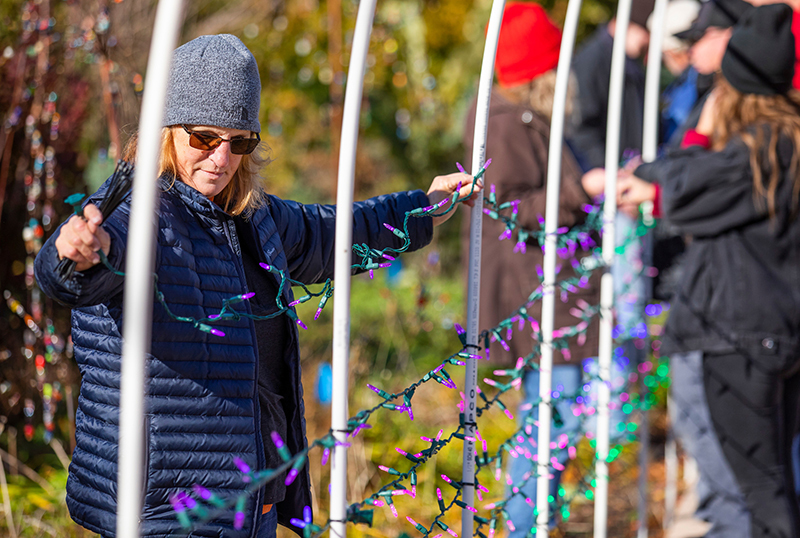
Photo by Christopher Gannon.
Sharon Rink, Reiman Gardens horticulturalist, worked with volunteers Tuesday morning to install lights on a display at Reiman Gardens. It's all hands on deck this week and next as gardens staff prepare for the second annual Winter Wonderscape outdoor holiday light show, which opens Dec. 2 and runs Thursday, Friday and Saturday evenings through Jan. 1. Time-reserved tickets may be purchased online.
Leaders share staffing guidelines for winter break weeks
University employees are encouraged to use accrued vacation time during next month's winter break, Dec. 20-Jan. 14, both for their own well-being and to reduce campus energy use. By chance, winter break this year coincides exactly with Iowa State's second winter session. While the four-week term will be 100% virtual, the first priority is to support winter term students and a successful second pilot.
In an Oct. 27 memo, senior vice president for operations and finance Pam Cain and vice president for university human resources Kristi Darr provided work guidelines for the four-week period. They support time off for employees, including closed offices during a portion of winter break, as long as essential operations (public safety, utilities) continue, research projects aren't impacted and customers -- including students -- receive the assistance they seek.
More information about university breaks
"We're encouraging supervisors and their employees to develop staffing plans that promote a healthy work-life balance," Darr said. "The semester break is a wonderful time to use accrued vacation to rest, catch up with family or visit friends."
Cain said the key will be to communicate any changes to the normal schedule in multiple places: on phone messages, office doors, websites, social media sites, etc.
Following are highlights from their campus message:
Break office hours
Offices may implement break hours, 7:30 a.m.-4 p.m., from Monday, Dec. 20, through Friday, Jan. 14. Employees should be "fully engaged" and performing regular duties and responsibilities over the break period, especially services for students and customers.
Partial closing option
If their workload allows, offices have the option of closing the week of Dec. 27, which includes two university holidays: Dec. 27 and 31. Employees with sufficient accrued vacation time who use three vacation days, Dec. 28-30, in effect achieve 10 days away from the office (Dec. 24-Jan. 2). Employees may choose to take unpaid time off, but it isn't required.
"Winter session operates that week and we'll be educating students, so offices that serve students still need to have a plan for how that will happen," Cain said.
Units should get approval from their division leader or a delegate for a weeklong closure, and employees should request the time off through the usual Workday channel. If necessary, supervisors are responsible for finding duties for employees who want to work.
More guidelines
Take vacation. To support and encourage work-life balance, Cain and Darr asked supervisors to work with their staff to accommodate vacation requests during winter break.
Access to buildings. All units should work with their building supervisor (available on this building information menu) to coordinate access to their building during the four weeks.
Student employees. For purposes of student employment, Dec. 20-Jan. 14 are considered non-academic weeks. If a unit has work available for them, supervisors may schedule student employees for more than 20 hours per week.
Not certain? Employees should direct questions about their unit's winter break plans to their supervisors. Questions about time-off processes over winter break can be directed to their HR delivery team.
Partnership expands COVID-19 testing options for university, Ames communities
A drive-thru clinic is available for faculty, staff and students needing a COVID-19 test. Iowa State is partnering with Hy-Vee to offer the clinic near Stephens Auditorium for the university and Ames communities. The clinic offers both lab and rapid PCR testing for anyone experiencing symptoms, exposed to someone with COVID-19 or needing a test for upcoming holiday travel.
Appointments are required; register at www.hy-vee.com/covidtesting. The clinic is open from 9 a.m. to 1 p.m. weekdays except Wednesday. Hy-Vee pharmacy staff members will provide patients with a test kit and instructions on how to self-administer, and supervise administration of the test. Patients must wear a mask to the site and lower it beneath their nose during the test.
Drive-thru COVID-19 testing site
- 9 a.m.-1 p.m. Monday, Tuesday, Thursday and Friday each week until further notice
- Lot F (west of Stephens Auditorium), enter from Beach Avenue
The drive-thru testing clinic is located in Lot F, west of Stephens Auditorium. Patients should enter the testing area from Beach Avenue onto Center Drive and follow signs.
Testing options
Two tests are available at this clinic:
- A free lab test (molecular PCR) is available to patients 3 years and older. Patients will receive test results by email in three to five days.
- The rapid PCR test costs $119 and is available to patients 5 years and older. Test results are available in as few as 30 minutes (up to one day) and will be sent by email to the patient.
Symptomatic students are still encouraged to get tested through Thielen Student Health Center. Test Iowa at-home testing kits also are available for students, faculty and staff at the TSHC front desk, Memorial Union information desk near the Cardinal Room, Union Drive Community Center mailroom and 2270 College of Veterinary Medicine (office of academic and student affairs).
More information about campus testing, vaccination clinics and public health data is available on the COVID-19 Moving Forward page.
Fend off ransomware with cybersecurity common sense
With numerous high-profile cases making recent headlines, ransomware may seem like a new phenomenon. That's only half right. The threats criminals are making are relatively new, but the methods they're using to breach computers are old standbys, the head of ISU's cybersecurity team told the Professional and Scientific Council at its Nov. 3 meeting.
"Nothing has changed. Hackers break in the same way they always have. Ransomware is just a different way to monetize it," said Rich Tener, chief information security officer for information technology services (ITS).
Ransomware is a type of malware that allows an extortionist to encrypt all of your files, demanding payment to unfreeze them. An attack on a personal computer could endanger a collection of family photos. A compromised university computer could mean losing sensitive research data or student information.
"It's almost like they're walking into your house, locking up all your valuables in a safe they brought with them and then not giving you the code until you pay them," Tener said.
In a presentation to the council, Tener outlined some tips for how employees can defend themselves and the university from ransomware. Here are some highlights.
Always back up
A key method of protection is making sure to regularly back up your files, which also has value in case of any other storage failure. Google offers a free option, Tener said. Those who have wisely backed up their files can restore them, though ransomware attackers may then threaten to publicly release the data they've seized, he said.
Secure your accounts
It may be tempting to reuse a password across your numerous accounts, but it’s not safe, Tener said. When hackers steal a password, they likely will try to access other accounts linked to you with that password. Nobody walks around with dozens of passwords memorized, though. Use a password manager such as LastPass, 1Password, KeePass or Dashlane, which create unique and strong passwords for each of your accounts. Then you only need to remember one password.
Email deserves special care
Be especially careful to make your personal email account secure by enrolling it in multifactor authorization, which requires logging in with both your password and a separate identification method -- often a code sent to your phone. With multifactor authorization in place, a stolen password isn’t enough for a hacker to access your email. Anyone with access to your email can unlock many of your accounts via the password recovery process, Tener said.
Pay attention
At Iowa State, all password-protected logins require multifactor authorization with Okta. Using the Okta mobile app, users don’t even have to enter a code and can just click a button acknowledging they’re trying to sign in. If you’re not actively signing in and get an Okta notification to verify your identity, make sure to deny access and contact the ITS security team at security@iastate.edu, Tener said.
Also be on the lookout for phishing and scams. Be skeptical about unusual requests that seem to come from colleagues and supervisors, and inspect the message header to make sure it’s a legitimate ISU address if the request comes by email. Don’t open unsolicited Microsoft Office attachments. Send a note to the security team if you’re suspicious.
Real updates, fake updates
Keeping software updated is crucial for patching security holes that hackers can exploit, but watch out for pop-up browser windows that suggest you need a software update. Legitimate software updates should come via system notifications, while fraudulent software updates always come via browser window, Tener said.
Know the source
When you’re downloading new software, only use trusted sources. Apple and Google app stores and ISU’s self-service and software centers are ideal places to download common programs.
Be proactive
Wondering if your account information has been stolen in a security breach? Tener said there’s an easy way to find out. Enter your email address in haveibeenpwned.com, which searches dark web databases to identify what accounts associated with that address have been compromised.
Security problem?
Think you might have a security issue with your computer? Or just have a question? Contact the ITS security team at security@iastate.edu.
The library's quest to fill gaps and perspectives in Iowa State's history
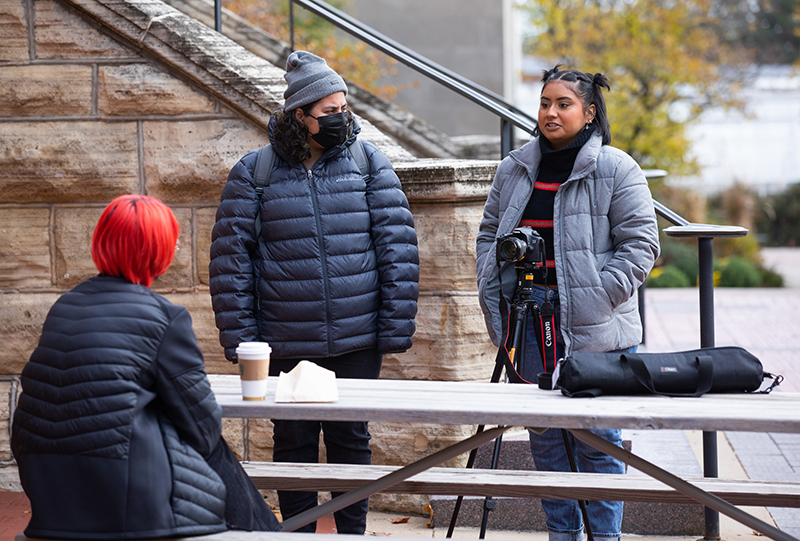
Journalism students Amber Mohmand (left) and Victoria Reyna-Rodriguez record their interview with English junior Cyndi Mahan Wednesday outside Catt Hall. As part of one of the initial Tracing Race projects, journalism students of Deni Chamberlin and Brenda Witherspoon are practicing investigative journalism concepts to explore race, racism and activism at Iowa State. Photo by Christopher Gannon.
For more than 50 years, the University Library has collected thousands of materials from students, faculty and staff. Scrapbooks, photographs, meeting minutes and stories give us a glimpse into our history as Cyclones. Still, this storied past paints an incomplete picture. Through initiatives such as Tracing Race at Iowa State and collection expansion efforts, the library seeks to uncover a nuanced account of the university's history -- one that includes the experiences and voices of Cyclones of color.
Expanding our historical narrative
Last summer, the library launched its Tracing Race at Iowa State initiative. The effort supports and facilitates digital scholarship projects that help Cyclones investigate our past, acknowledge injustice and work to reveal forgotten or even untold stories. It springs from library dean Hilary Seo's collaboration with President Wendy Wintersteen to explore ways to digitally share the history of race and activism at ISU.
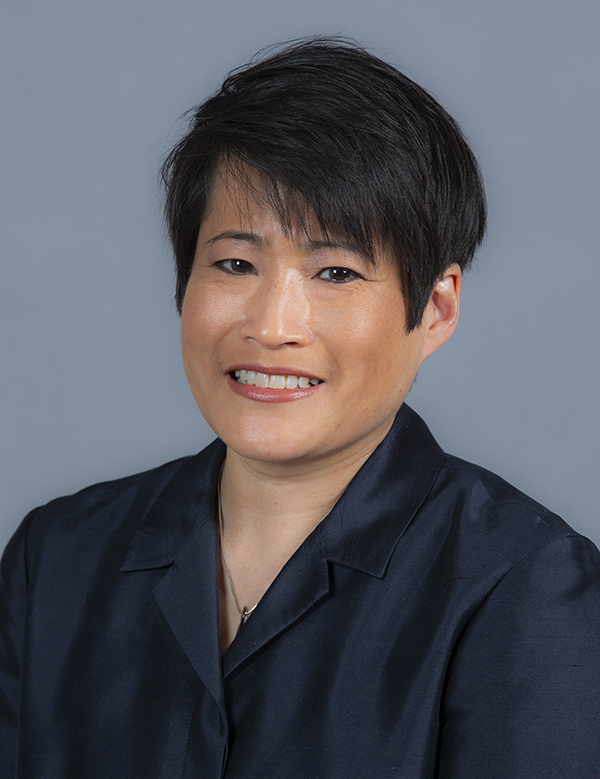
Seo
"It's important that this project not only represent milestones on our campus and celebrate progress, but help us unearth and preserve stories that more completely reflect our history," Seo said. "With Hannah [Scates Kettler] and Erin [Ridnour]'s leadership, we developed an inclusive and sustainable way to generate content and give students experiential learning opportunities that broaden their perspectives."
Digital scholarship has transformed the way we obtain, interpret and share research. Everyday examples include data maps of COVID-19 cases worldwide, overlays of before and after aerial photographs documenting the destruction of natural disasters, and interactive timelines.
Teams with Tracing Race projects have access to resources and support, including guidance from an advisory committee and training by staff from the digital scholarship and initiatives (DSI) and special collections and university archives (SCUA) departments.
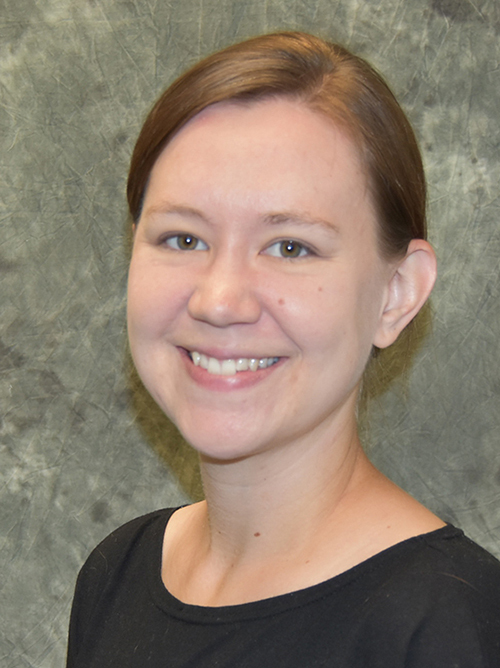
Ridnour
"We didn't want this to be a one-off exhibit; it's an ongoing effort and commitment," said Ridnour, digital scholarship librarian and project lead for Tracing Race. "And we wanted to move this initiative beyond the library to include anyone on campus who's interested in digging into the history to build something creative."
In June, the group announced its first round of selected projects. One is from Gloria Betcher, teaching professor of English, who will explore the off-campus housing experiences of Black students. Another is by Deni Chamberlin, associate professor, and Brenda Witherspoon, associate teaching professor, both in the Greenlee School of Journalism and Communication. They will integrate the project into their coursework and build on investigative journalism concepts on topics of race, racism and activism at Iowa State.
The program comes at a time when many institutions are confronting their difficult histories by revealing buried stories in their archives and making them openly available, often through digital means. Such efforts take courage -- and support.
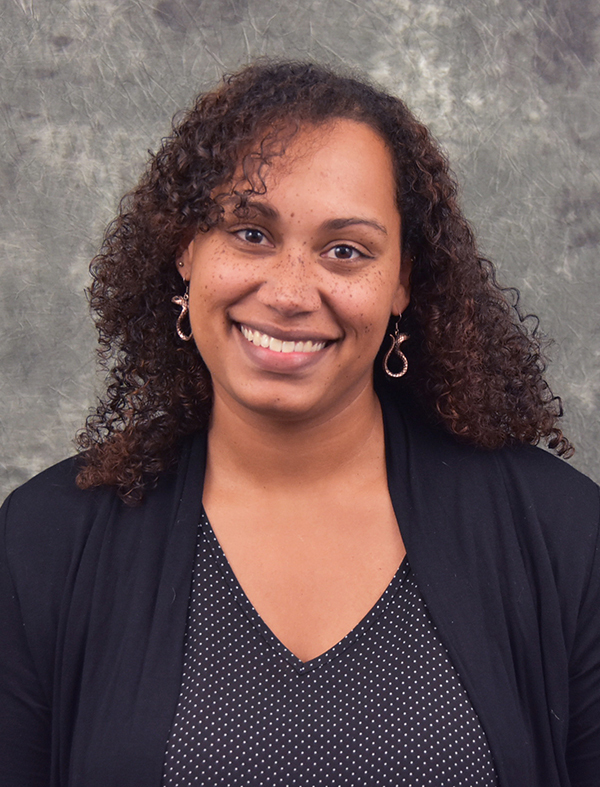
Scates Kettler
"Inevitably, this will uncover things that are uncomfortable for the institution," said Scates Kettler, head of DSI. "However, there's a network of people across campus, including our president and provost, committed to this work. Support is key to the success of this project."
A seven-member interdisciplinary advisory committee convenes routinely to review project proposals and provide varying perspectives. They represent campus units including history; Latino/a studies; African and African American studies; office of diversity, equity and inclusion; dean of students office; and multicultural student affairs.
Students and 'difficult conversations'
The Tracing Race initiative includes a grant program (up to $2,500) for student-led projects. This part of the initiative helps students build the hard and soft skills needed to expand their cultural competence and mold them into well-rounded leaders.
"They'll work together to have the difficult conversations and navigate human communication and emotional intelligence," said Scates Kettler. "These skills are highly sought and needed in today's working world."
Student teams, too, may receive research, development or training support from library staff or a faculty mentor. For example, through library-led training sessions, teams learn to use materials held deep within SCUA to inform their research.
"Some of our primary sources don't often get looked at or revealed. In looking at these sources, the teams are uncovering voices in our own archives," she said.
Scates Kettler also believes participants may uncover passions in themselves.
"Students are learning about self-advocacy, allyship and social justice," she said. "Uncovering this history is a form of activism in itself. We hope students create a connection with the work they're doing and see the variety of context in which advocacy, allyship and social justice can occur."
Gaps in past archival efforts
SCUA staff also are exploring ways to expand their collection development efforts. While the department holds more than 1,800 digital and physical collections, SCUA head Daniel Hartwig acknowledges there are shortcomings in its practices and staff are designing initiatives to collect, share and prioritize voices of color.
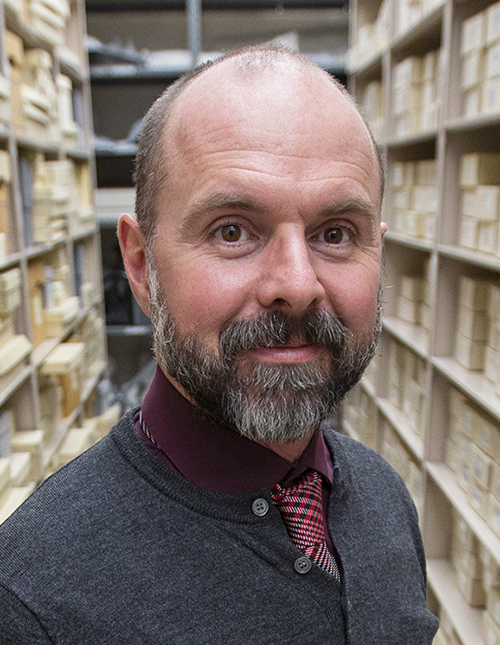
Hartwig
Hartwig said traditional collection development practices are a systematic problem for many reasons, intentional or unintentional. Many university archives were established in the 1960s, and early collection development was fueled by rank, influence and access, skewing and limiting the voices and experiences included. However, the library -- and the archival profession in general -- are working to repair and restructure the narrative they tell, he said. Newer strategies shift ownership from the library back to contributors.
"Thankfully, there's been a change in the profession to center Black and all underrepresented voices," Hartwig said. "The impact of limited collections is that people don't see themselves. They don't feel a part of the narrative. They don't find their history. They sense erasure."
SCUA staff recognize that trust is at the core of not just storytelling but cultivating better relationships with the communities they wish to serve.
"Usually, people donate materials as a gift and transfer rights to them. Although it's easier, it can be deemed as taking thoughts and controlling output," Hartwig said. "We now use creative commons licensing so people can retain their rights and control use, or we use practices such as scan and return, to allow individuals to retain original items. These changes in rights and ownership have helped build trust with individuals."
Another strategy is the post-custodial approach, which equips communities with the support and information needed to be their own archivists. Through workshops, SCUA staff teach local organizations how to safeguard their materials, transferring knowledge and insights usually held within the university into nearby communities.
"It's gone from us being the custodians of everything to being in a more support role," Hartwig said.
Resources to expand your DEI learning
Burgeoning on- and off-campus partnerships continue to help the library move the needle toward fuller, more inclusive stories. New oral history initiatives are underway with ISU groups, including faculty and staff associations. And hundreds of deteriorating audio and video recordings featuring diverse speakers and subject matter are being digitized and made available online.
From diversity collections and online exhibits to research guides, the library has hundreds of materials to help further your DEI journey. Access virtual resources and learn more about its DEI efforts.
University assists with temporary care for rescue dogs
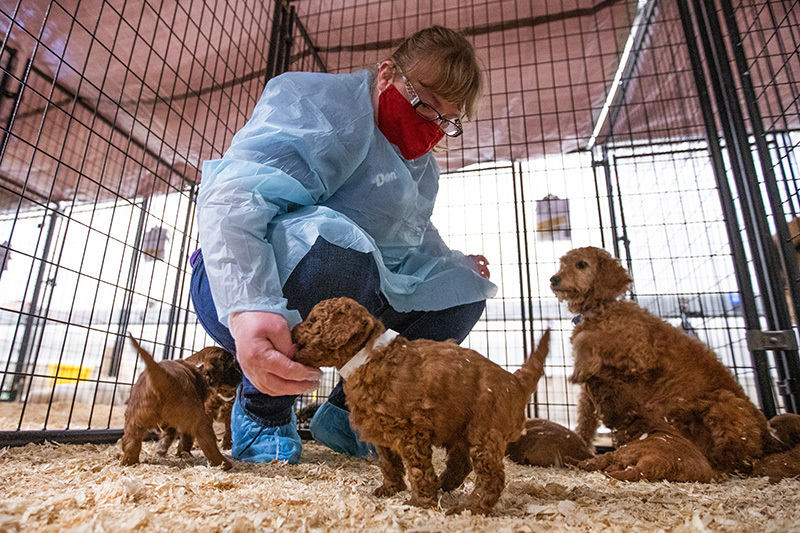
Veterinary medicine student Natalie Biddle checks on a litter of puppies and their mother at the Hansen Agriculture Student Learning Center. A total of 52 undergraduate students, 22 veterinary students and five ISU staff members registered as American Rescue League of Iowa volunteers to contribute their time to the rescue effort. Photos by Christopher Gannon.
Dogs are man's best friend, and sometimes they need a helping hand. Iowa State Veterinary Medicine and animal science students are volunteering their time to help dogs that were part of a rescue effort that began Oct. 14 in southern Iowa.
More than 500 dogs and puppies were removed from a licensed breeder in Seymour and surrounding areas at the request of the U.S. Department of Justice because of horrific living conditions. ISU received 115 dogs that were brought to the Hansen Agriculture Student Learning Center, one which is in the Lloyd veterinary hospital. The dogs are housed in spacious kennels adjacent to the rodeo ring, where student volunteers were serving them lunch Wednesday afternoon. Most of the dogs had adjusted to the improved conditions and were calm and quiet in their surroundings.
Veterinary students who are assisting administer rabies vaccinations, conduct low-stress handling and do a few procedures. A large group of undergraduate students perform care tasks such as kennel cleaning and preparing food and water, said Suzanne Millman, professor of veterinary diagnostic and production animal medicine.
Some veterinary students also were part of the removal operation, where they worked with U.S. Department of Agriculture inspectors.
"As dogs were coming out of facilities, there was a staging area in Wayne County, and our students were assisting with handling and restraining the dogs, microchipping and doing an inventory of the dogs," Millman said.
Des Moines-based Animal Rescue League of Iowa (ARL) is in charge of the temporary shelter and has a memorandum of understanding with the university that runs through Nov. 12. Three rescue dogs have given birth to a litter of puppies since arriving in Ames.
None of the rescue dogs in Ames currently are available for adoption, but other dogs from the rescue sites can be adopted. Visit the ARL website for more information. Adoption is on a first-come, first-served basis.
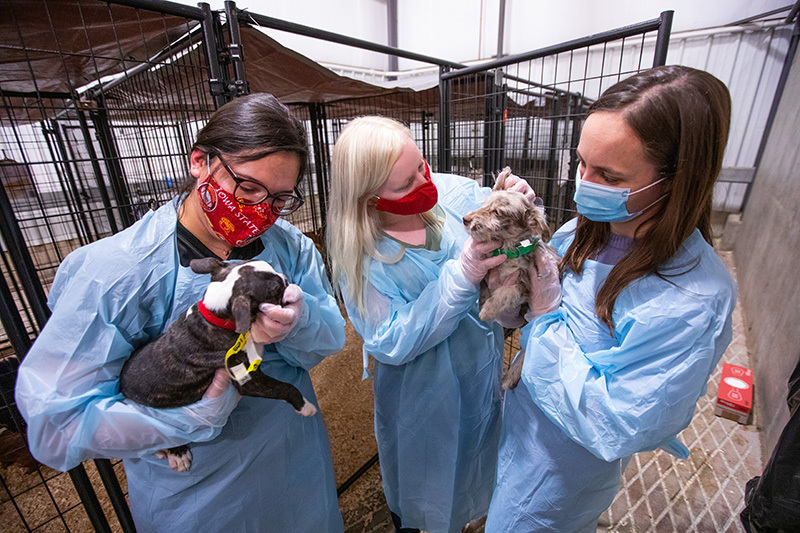
Veterinary medicine students (l-r) Melissa Garcia Rodriguez, Katie Willoughby and Katherine Hauptmann perform wellness checks on two of the dogs being cared for by the Animal Rescue League and the College of Veterinary Medicine at the Hansen Agriculture Student Learning Center.
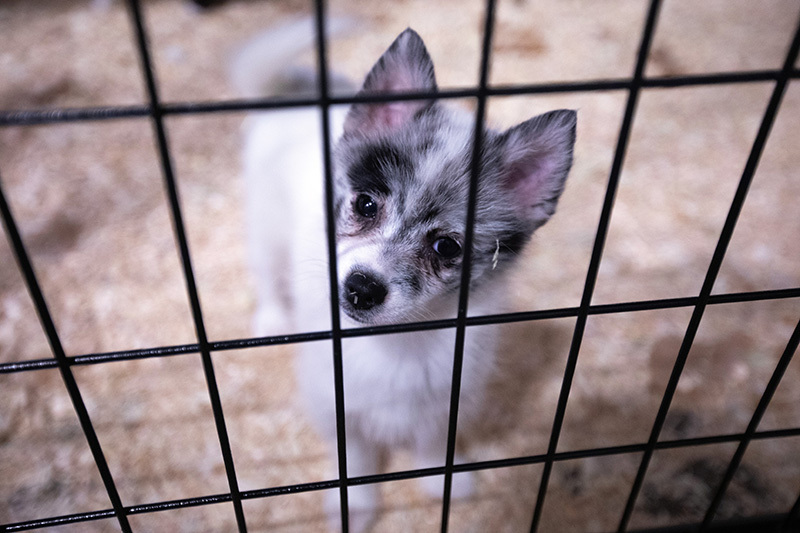
One of the 115 dogs being cared for by the Animal Rescue League and Veterinary Medicine College at the Hansen Agriculture Student Learning Center.
ISU Wind Ensemble to honor Sousa's performance in Ames
A few years ago Michael Golemo, University Professor and director of bands at Iowa State, was flipping through a book listing the 15,000-plus performances of the John Philip Sousa Band when something caught his eye -- a Nov. 11, 1920, concert performed in Ames at State Gym.
According to a review by the Ames Daily Tribune, "over 4,000 people" packed into the gym to hear the famed Sousa Band perform an Armistice Day program that was "eclectic and satisfying to all lovers of music."

The ISU Wind Ensemble plans to honor that historic event and recreate its patriotic pride during a 101st anniversary concert and tribute to Sousa on Veterans Day, Nov. 11, at 7 p.m. in State Gym. Tickets are $15 (cash or check) and can be purchased in 149 Simon Estes Music Hall or at the door.
Originally planned for the 100th anniversary, the concert was postponed due to the COVID-19 pandemic.
"We thought it would be neat to do a 100th anniversary concert," Golemo said. "It was his only concert in Ames, so that's significant. It will be a patriotic concert in the Sousa style. We're going to have a narrator there to put you back in that time frame."
Program to feature Lance LaDuke, surprise finale guests
The ISU Wind Ensemble's program will be modeled after a traditional Sousa concert, with marches as encores and a featured soloist. Musical selections will include: "The Light Cavalry Overture" by Franz von Suppé; "O mio babbino caro," by Giacomo Puccini, with euphonium soloist Lance LaDuke; and Sousa's own "The Stars and Stripes Forever."
LaDuke is an internationally known educator, performer and creator who has played in more than 25 countries and all 50 states. A faculty member at Carnegie Mellon University in Pittsburgh, Pennsylvania, he is a former member of the U.S. Air Force Band in Washington, D.C., among other prestigious bands.
"He is a virtuoso who will do some things that will just be smoking," Golemo said. "He's really an incredible musician."
Veterans and members of the Armed Forces also will be recognized, Navy and Marine ROTC units will present the colors and John Burnett-Larkins, announcer for the Cyclone Marching Band, will serve as emcee. A finale will feature surprise special guests. Golemo hopes the pageantry will convey just how special the Sousa Band's Ames performance must have been a century ago.
"When the Sousa Band came to town, the schools shut down, the businesses shut down," he said. "This was a once-in-a-lifetime opportunity to hear real classical music. It was extremely special, and we're trying to give the historical perspective of what this was about."
Golemo, a self-described "Sousa-holic," also planned a tribute that will last long after the final notes from the anniversary concert fade away. He'll unveil a historic plaque, sponsored by the John Philip Sousa Band Foundation, to honor the site of the band's 1920 State Gym performance.
"This will be really special," Golemo said. "It will be a big splash."
'An authentic cultural hero'
Known as "The March King," Sousa is best remembered for his marches, but what people don't often know, Golemo said, is that he brought classical music to small towns and places around the world. In a time before radios, records and phonographs became common household items, the Sousa Band crisscrossed the globe introducing audiences to the sounds of Wagner, Rossini and Verdi.
A prolific composer and arranger, Sousa expanded the available repertoire for concert bands, which were still in their infancy at the turn of the 20th century, Golemo said. Sousa commissioned transcriptions of orchestra music and wrote original compositions for band, piano and vocal performance.
Golemo said Sousa fell in love with touring as conductor of the "The President’s Own" United States Marine Band. After 12 years in the role under five presidents, Sousa organized his own civilian band and went on tour.
"He played in Africa, Europe, Asia and Australia," Golemo said. "He was playing classical overtures and music that hadn't even been performed by the Metropolitan Opera in New York, and he's playing it in small towns in Kansas and Iowa. He was known for bringing quality music all around."
